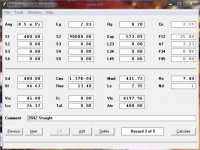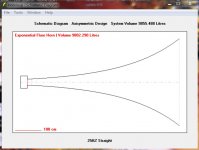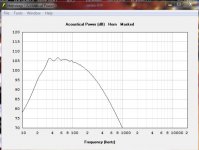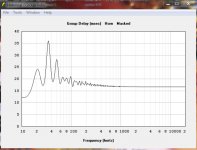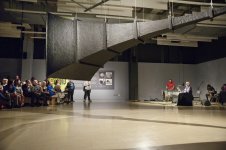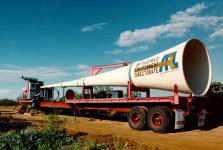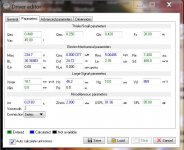Hi All.
I've been trying to wrap my head around Hornresp for a little while now in order to design a full size 30HZ horn, but I am having difficulty reading my results. I would like to build two horns for "stereo". These horns will be crossed over to a two way horn loaded speaker at 80-100HZ. I will probably use a La Scala bass bin or similar with a single large horn for the high frequencies.
I know that this will make for a very large horn, but I do have the space for it, and I would like to use the concrete walls and floor of a large space for two of the four walls of the horn. This system will be used for listening to music, not for PA, so sound quality is more important than SPL.
I have attached a couple of photos of the Hornresp simulation for your consideration, and I have a few questions.
1. If I use the throat area, the mouth area and the horns length as primary design criteria and either ignore or roughly approximate the flare rate, would that have a large impact on the horn's sound quality?
2. I have a pair of Alpine SDR 1222D at hand, and the sim is for these speakers, but I will build the throat/back chamber so that it will be easy to swap out drivers or change the sealed back chamber size. I have a couple of pro amps that have plenty of power for these speakers. Are these 12 inch Alpine Type R speakers a good choice?
3. If I were to build the horns with at least a rough approximation of the exponential curve, where do I get the required measurements? Am I missing something in Hornresp that shows these measurements other than the schematic?
Sorry if these are noob questions, but that would be a good description of my relationship with Hornresp. Any assistance/advice that you can provide would be much appreciated.
I've been trying to wrap my head around Hornresp for a little while now in order to design a full size 30HZ horn, but I am having difficulty reading my results. I would like to build two horns for "stereo". These horns will be crossed over to a two way horn loaded speaker at 80-100HZ. I will probably use a La Scala bass bin or similar with a single large horn for the high frequencies.
I know that this will make for a very large horn, but I do have the space for it, and I would like to use the concrete walls and floor of a large space for two of the four walls of the horn. This system will be used for listening to music, not for PA, so sound quality is more important than SPL.
I have attached a couple of photos of the Hornresp simulation for your consideration, and I have a few questions.
1. If I use the throat area, the mouth area and the horns length as primary design criteria and either ignore or roughly approximate the flare rate, would that have a large impact on the horn's sound quality?
2. I have a pair of Alpine SDR 1222D at hand, and the sim is for these speakers, but I will build the throat/back chamber so that it will be easy to swap out drivers or change the sealed back chamber size. I have a couple of pro amps that have plenty of power for these speakers. Are these 12 inch Alpine Type R speakers a good choice?
3. If I were to build the horns with at least a rough approximation of the exponential curve, where do I get the required measurements? Am I missing something in Hornresp that shows these measurements other than the schematic?
Sorry if these are noob questions, but that would be a good description of my relationship with Hornresp. Any assistance/advice that you can provide would be much appreciated.
Attachments
There is so much muddled thinking here that I wonder how you got to this stage?
Why Horns? You have a couple of high power woofers for use in a car - an entirely different proposition from a horn speaker. Horn loaded speakers - best use drivers designed for the job.
Your question 1 is very important. YES it absolutely does matter!
Horns are super super efficient - so high power pro amps are absolutely not needed.
A straight 25Hz Horn is so enormous that the mechanical problems in fabricating and holding the weight of such a thing are a serious engineering issue.
And do you need 2 for stereo? at such frequencies, directional information is missing and a properly designed single unit will work - that is how Home Theatre subs are typically designed
And you still have left truly epic questions about how you integrate these Horns with other units to make a satisfying whole - and a lot of that is specific to your listening space.
You might find this old design interesting: (John Crabbe Horn design) Hi-Fi, DIY Projects
Why Horns? You have a couple of high power woofers for use in a car - an entirely different proposition from a horn speaker. Horn loaded speakers - best use drivers designed for the job.
Your question 1 is very important. YES it absolutely does matter!
Horns are super super efficient - so high power pro amps are absolutely not needed.
A straight 25Hz Horn is so enormous that the mechanical problems in fabricating and holding the weight of such a thing are a serious engineering issue.
And do you need 2 for stereo? at such frequencies, directional information is missing and a properly designed single unit will work - that is how Home Theatre subs are typically designed
And you still have left truly epic questions about how you integrate these Horns with other units to make a satisfying whole - and a lot of that is specific to your listening space.
You might find this old design interesting: (John Crabbe Horn design) Hi-Fi, DIY Projects
You should use a driver with smaller xmax in a horn, massive SPL can be achieved with small cone movement. High xmax drivers have significant portion of the voice coil outside the magnetic gap where it cannot conduct heat to the magnet effectively. They required forced air cooling caused by movement to avoid overheating, however the horn will stop the cone moving which means the heat is trapped. Furthermore high xmax drivers are less efficient and have a greater Qes than smaller xmax drivers as the coil outside the magnetic field adds series resistance but does not increase the motor force of the driver. A classic horn driver would be something like the B&C 8PE21, low Qes, high sensitivity and relatively low xmax. I'm not suggesting this driver for your horn (its more of a mid) and you may still need more than 2.5mm xmax for a bass horn, but you should carefully work out what xmax you actually need and not specify extra in this application.
Thanks for all the speedy replies.
I have the Alpine drivers handy, their original intended use was in a sealed box with a big amp to supplement a pair of La Scalas in another room, so I figured I’d ask. Thanks for explaining why they won’t work well in a horn. I recall ChrisA recommending them for horns at some point, but perhaps that was a different type of horn.
I understand why I shouldn’t need two. However, in my experience with other subwoofers, localization often seems to be a problem when using a single sub. This is especially true when lower order crossovers are used. Also, in my experience, two (or more) subs even out the bass in room. At any rate, I have the room and the ability to do so, so that’s what I’m going to do.
With respect to the construction, as long as I keep the expansion correct, is there any reason why the horn can’t use the floor and one wall as part of the horn? It just doesn’t seem that difficult to me. I’m pretty handy though.
Integration will be through a three way active crossover with delay capability. I will use REW and a Umik-1 to dial it in. I would think that getting a big horn to aurally integrate with two other horns would be easier than integrating with non horn bass units.
David Morison, thanks for that. I didn’t see it in the tutorial I read.
I will check out all the links that you all so kindly provided.
Thanks again.
I have the Alpine drivers handy, their original intended use was in a sealed box with a big amp to supplement a pair of La Scalas in another room, so I figured I’d ask. Thanks for explaining why they won’t work well in a horn. I recall ChrisA recommending them for horns at some point, but perhaps that was a different type of horn.
I understand why I shouldn’t need two. However, in my experience with other subwoofers, localization often seems to be a problem when using a single sub. This is especially true when lower order crossovers are used. Also, in my experience, two (or more) subs even out the bass in room. At any rate, I have the room and the ability to do so, so that’s what I’m going to do.
With respect to the construction, as long as I keep the expansion correct, is there any reason why the horn can’t use the floor and one wall as part of the horn? It just doesn’t seem that difficult to me. I’m pretty handy though.
Integration will be through a three way active crossover with delay capability. I will use REW and a Umik-1 to dial it in. I would think that getting a big horn to aurally integrate with two other horns would be easier than integrating with non horn bass units.
David Morison, thanks for that. I didn’t see it in the tutorial I read.
I will check out all the links that you all so kindly provided.
Thanks again.
Last edited:
Tizman,1)I have the Alpine drivers handy, their original intended use was in a sealed box with a big amp to supplement a pair of La Scalas in another room, so I figured I’d ask.
2)At any rate, I have the room and the ability to do so, so that’s what I’m going to do.
3)With respect to the construction, as long as I keep the expansion correct, is there any reason why the horn can’t use the floor and one wall as part of the horn?
4)I would think that getting a big horn to aurally integrate with two other horns would be easier than integrating with non horns.
1)Alpine Type R drivers have been used in many horn applications, and most contemporary high output horn subs use long excursion drivers with similar Xmax. You will probably have sheetrock cracking, stuff falling from shelves, pictures rattled off walls, long before the drivers have any heat-related issues, a few watts into each could pull nails from wall board with horns the size you contemplate.
The BL listed in your sim (44.63) seems much higher than I recall of any driver of that type, you might want to confirm the specification. Also, an even higher sensitivity could be achieved using a reduced throat size- 1/3 the driver's Sd should be no problem.
2) If you are considering a pair, you must have a huge room! What are your room dimensions?
3) Using the floor and one or more walls for part of the horn mouth walls is not a problem, though mechanical vibration to other parts of the house may be.
4) Integration of a pair of huge, presumably immovable horn subs will not be as easy as integrating smaller front or bass reflex that could be moved relatively easily.
Art
Last edited:
Hi Art.
Thanks for your reply!
1. The BL is incorrect. I am still learning Hornresp, and I think I messed up the parameters by allowing it to auto fill in some of them. I will redo the sim with the proper ones. I'm glad to hear that these will be workable drivers! Are there any advantages other than increased efficiency that result from reducing the throat size? Are there any disadvantages to reducing the throat size as compared to not doing so?
2. The room is 35 by 50 feet with 11 foot ceilings. I have had enough issues with being able to localize subs in the past to make me want to either use one in a central location or to use a pair spaced as though for stereo. I know it's probably overkill building two, but it's going to be difficult putting one in the middle.
3. I had not considered the increase in mechanical vibration that could result from using the floor and walls as part of the horn. Do you think that it would be substantially more than what would result from energizing the room once the sound exits the horn mouth in a horn that didn't use a wall and the floor as part of the enclosure?
4. These horns will most definitely not be movable. I will be using extensive room treatments, so hopefully I can further tune in that way.
Thanks for your reply!
The BL listed in your sim (44.63) seems much higher than I recall
1. The BL is incorrect. I am still learning Hornresp, and I think I messed up the parameters by allowing it to auto fill in some of them. I will redo the sim with the proper ones. I'm glad to hear that these will be workable drivers! Are there any advantages other than increased efficiency that result from reducing the throat size? Are there any disadvantages to reducing the throat size as compared to not doing so?
2. The room is 35 by 50 feet with 11 foot ceilings. I have had enough issues with being able to localize subs in the past to make me want to either use one in a central location or to use a pair spaced as though for stereo. I know it's probably overkill building two, but it's going to be difficult putting one in the middle.
3. I had not considered the increase in mechanical vibration that could result from using the floor and walls as part of the horn. Do you think that it would be substantially more than what would result from energizing the room once the sound exits the horn mouth in a horn that didn't use a wall and the floor as part of the enclosure?
4. These horns will most definitely not be movable. I will be using extensive room treatments, so hopefully I can further tune in that way.
These are the driver parameters for the Alpine SDR-1222D as taken off of WinISD.
The Hornresp equivalents to the given WinISD driver parameter values are:
Sd = 480.00
Bl = 26.42
Cms = 1.37E-04
Rms = 5.03
Mmd = 229.77
Le = 2.35
Re = 7.40
An observation, from your simulations results a volume of 10'000L, that is 10m3.
Are you shure that you are able to build a soo big horns?
You can evaluate other type of load like the DCAC, for example a sub like this:
T-Project 14: Subwoofer in DCAC
Excuse me for the link in italian, but this sub have a f-3dB at 25Hz in a 160L box.
Are you shure that you are able to build a soo big horns?
You can evaluate other type of load like the DCAC, for example a sub like this:
T-Project 14: Subwoofer in DCAC
Excuse me for the link in italian, but this sub have a f-3dB at 25Hz in a 160L box.
1) An increase in efficiency means less real estate can achieve the same output. The only disadvantage would be the cone is put under more stress when used to full excursion, which may increase distortion slightly.1. Are there any advantages other than increased efficiency that result from reducing the throat size? Are there any disadvantages to reducing the throat size as compared to not doing so?
2. The room is 35 by 50 feet with 11 foot ceilings. I know it's probably overkill building two, but it's going to be difficult putting one in the middle.
3. I had not considered the increase in mechanical vibration that could result from using the floor and walls as part of the horn. Do you think that it would be substantially more than what would result from energizing the room once the sound exits the horn mouth in a horn that didn't use a wall and the floor as part of the enclosure?
2) One will be overkill...
3) The SPL within the horn continues to increase over the what the level at the mouth is, so the increase in mechanical vibration also varies at approximately the inverse distance law, about 6 dB more vibration noise a meter inside the horn than a meter from the mouth. That said, whether the mechanical vibration noise is a problem really depends on the wall/floor construction and materials.
Tizman,
1)Alpine Type R drivers have been used in many horn applications, and most contemporary high output horn subs use long excursion drivers with similar Xmax. You will probably have sheetrock cracking, stuff falling from shelves, pictures rattled off walls, long before the drivers have any heat-related issues, a few watts into each could pull nails from wall board with horns the size you contemplate.
This is also true and I think my previous reply was more focused on my particular use cases rather than a typical users use case. The power handling of the driver is reduced by the horn loaded application but also the efficiency is very high. So Unless you want to achieve the maximum possible power output of the cab on music content (which usually only goes down to 40 Hz), especially at home, then the heating of the voice coil is going to be minimal as the average power is low.
I really should work on putting one horn in a central location. I have been fiddling with Hornresp, and the the large horns that I am simulating are very efficient, even with the very inefficient Alpine drivers. I am going to play with a Lab 12 driver in a big horn to see what that looks like.
Finally, a topic that I can legitimately comment on.
Yes, I have built a 30Hz almost straight (one 180 degree bend) exponential horn in my house.
The initial driver was an old 12 inch Richard Allan unit. It had low excursion, low Fs and low Qts. The system was about 100 dB/watt at 30 Hz. It now has a servo woofer using a velocity feedback loop. (Only because I could and I like experimenting.)
Lessons learned:
1. Making such a large structure rigid is difficult. Use the floor and a rigid wall to make up two sides. Use a constrained layer damping approach to the other two sides. Plus structural reinforcement.
2. Don't expect a simulation to give you exact results. Even in your large room you will wind up sitting inside the horn. The room will heavily modify the horn's output.
3. Make three sides of the horn straight and curve only one side (if you want to follow a specific area expansion profile precisely). The horn experts will tell you that at low frequencies it isn't necessary to have smooth area expansion at all. I made my horn to follow an exponential expansion as closely as was practical.
4. A huge bass horn isn't easy to integrate acoustically with other speakers. Especially other subwoofers. The fact that it isn't moveable is a substantial disadvantage. That only compounds the problem that the long delay through the horn causes. The great efficiency is a substantial advantage as you can apply lots of equalization without running into output limits.
5. I probably wouldn't do it again. I think the effort/cost is better spent building a bunch of subwoofers that can be placed around the room and using Dr. Geddes technique or MSO to get smooth bass.
Yes, I have built a 30Hz almost straight (one 180 degree bend) exponential horn in my house.
The initial driver was an old 12 inch Richard Allan unit. It had low excursion, low Fs and low Qts. The system was about 100 dB/watt at 30 Hz. It now has a servo woofer using a velocity feedback loop. (Only because I could and I like experimenting.)
Lessons learned:
1. Making such a large structure rigid is difficult. Use the floor and a rigid wall to make up two sides. Use a constrained layer damping approach to the other two sides. Plus structural reinforcement.
2. Don't expect a simulation to give you exact results. Even in your large room you will wind up sitting inside the horn. The room will heavily modify the horn's output.
3. Make three sides of the horn straight and curve only one side (if you want to follow a specific area expansion profile precisely). The horn experts will tell you that at low frequencies it isn't necessary to have smooth area expansion at all. I made my horn to follow an exponential expansion as closely as was practical.
4. A huge bass horn isn't easy to integrate acoustically with other speakers. Especially other subwoofers. The fact that it isn't moveable is a substantial disadvantage. That only compounds the problem that the long delay through the horn causes. The great efficiency is a substantial advantage as you can apply lots of equalization without running into output limits.
5. I probably wouldn't do it again. I think the effort/cost is better spent building a bunch of subwoofers that can be placed around the room and using Dr. Geddes technique or MSO to get smooth bass.
Finally, a topic that I can legitimately comment on.
Thanks for sharing your experience. The more input I get, and the more research I do, the more I’m inclined to change my plans. It seems that a couple of tapped horns running from 30 to 80HZ would be much easier to build and integrate.
Layhzer: that said, what was your 30HZ horn like once you finally got it integrated? Was it substantially better or different from other bass units?
I would say that I never got my horn fully integrated into my home theatre. It is capable of very low distortion impactful bass that typical small subwoofers just can't do. BUT flat (or at least smooth) bass is more important to me.
Tapped horns may be the way to get the best of both worlds. You can always sell them if you don't like them. I am stuck with my horn unless I want to do demolition.
Tapped horns may be the way to get the best of both worlds. You can always sell them if you don't like them. I am stuck with my horn unless I want to do demolition.
Abandoning the straight full size horn but still wanting the “real big” horn sound could lead one to explore the Danley BC (Boundary Coupled) horns.
Being not a tapped horn they are easier to integrate as they don’t have the abrupt phase changes tapped horns subwoofers have.
Barry.
Being not a tapped horn they are easier to integrate as they don’t have the abrupt phase changes tapped horns subwoofers have.
Barry.
I built a 30hz front horn. It has 2 180 degree bends. In my listening room I found the bass quality less precise than my over damped sealed subwoofers, although it was hard to make a fair comparison because placement of such a massive subwoofer is limited. In my theater, in a position that I had already tested to be ideal, it is awesome. Insanely loud. In my large theater, it would take a bunch of non-horn loaded subs to match its output. But make sure you have even bass tested from a sub in that position before you commit to a build. Most rooms do benefit greatly from multiple subs. Positioning is everything. Multiple th's probably does make more sense. Also a factor is making sure you have enough delay capability in your setup to compensate for the length of the horn.
- Status
- This old topic is closed. If you want to reopen this topic, contact a moderator using the "Report Post" button.
- Home
- Loudspeakers
- Subwoofers
- Very large 30HZ straight horn
